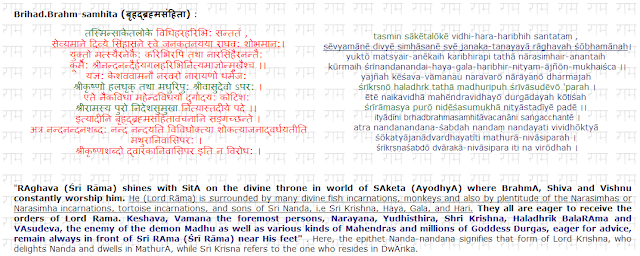with commentary by SWAMI B.V.TRIPURARI (GAUDIYA-SAMPRADAYA) -
http://swamitripurari.com/2010/08/gopala-tapani-upanisad/
DOWNLOAD (ENGLISH-SANSKRIT):
YandexDisk Cubby Box Dropbox AmazonCloud Filesnack Bitcasa 4sync
GoogleDocs Skydrive Ge.tt Mc.tt Mediafire 4shared
Annotation by Vishnudut1926: I love "Gopala-Tapani-Upanishad", but bear in mind the following nuisance: the middle part is mayavadic and Shree Krishna tells about ahangropasana (mayavadic meditation) in the middle part.
Don't be deluded by these mayavadic nuisances, because Bhagavan Shree Krishna has included them in "Gopala-Tapani-Upanishad" for the deception of silly and harebrained demons.
Of course, neither Shree Krishna nor Vaishnava-Acharyas ever support mayavadic ahangropasana, because it usually leads to Naraka-Loka or Kaivalya-Mukti, which is
atmaghata (आत्मघात) for soul and worse than Naraka, because jiva can return from Naraka, but can never return from the state of Kaivalya-Mukti.
Purna Purushottam Lord Shree Swaminarayan has spoken the following words about false brahm-gyanis (dead vedantins) in "Vachanamrita" (Gadhada II, 18.4): The shushka-vedãntis (dead or vain vedantis) believe that brahm itself has assumed the svarup of the jeevs – just as in the relationship between the sun and its reflection.
Therefore, when a person realises ‘I am brahm’, he has no further spiritual activities left to perform.
Then, when he has become Bhagvãn, he does not need to worship anyone. Thinking this, they no longer have fear in committing sins. Moreover, they believe, ‘We have attained the nirgun path, so we will not have to take birth again’.
However, the shushka-vedãntis do not examine their own understanding which implies that nirgun brahm, which is beyond Mãyã, will also have to pass through births and deaths. This is because they claim that brahm itself has assumed the svarup of all sthãvar and jangam objects.
This means that just as a jeev has to undergo births and deaths, brahm also has to undergo births and deaths.
Also, while they think, ‘We will be released from births and deaths’, they do not realise, ‘According to our own beliefs, births and deaths have become a reality for brahm itself.
Therefore, if we do develop deep understanding, at most we shall realise ourselves to be brahm-svarup. But even then, the cycle of births and deaths will still not be dispelled’.
As a result, by their own beliefs, moksh is proven false.
Nevertheless, no one examines this. Instead, they boast, ‘We are brahm-svarup, so who do we need to worship? Who do we bow to?’
Thinking this, they become extremely arrogant.
Even though they have not truly understood anything, they still have pride of their gnãn. However, they do not realise that their own moksh is proven false by their own beliefs. Moreover, they convert those who keep their company into fools as well.
However, bhaktas possessing true gnãn, such as Nãrad, the Sanakãdik, and Shukji, constantly perform dhyãn upon Bhagvãn, chant His holy name, and sing kirtans.
Even the niranna-muktas in Shvet-Dvip, who are brahm-svarup and who can control Kãl, continuously perform dhyãn upon Bhagvãn, chant His holy name, and sing kirtans about Him.
They also offer pujã, smear sandalwood paste on Him, and perform dandvats. Despite being akshar-rup, they behave as the dãs of Purushottam Bhagvãn.
Also, the residents of Badrikãshram, including Uddhav, Tanu Rushi, and the other munis, perform tap and continuously offer bhakti to Bhagvãn.
On the other hand, the shushka-vedãntis are completely oriented around their bodies.
Also, they do not perform dhyãn upon Bhagvãn, nor do they chant the name of Bhagvãn, and nor do they bow before Bhagvãn.
Compared to the power and gnãn of Nãrad, the Sanakãdik, and Shukji; and compared to the power and gnãn of the niranna-muktas who reside in Shvet-Dvip; and compared to the power and gnãn of the rushis who reside in Badrikãshram, these shushka-vedãntis do not possess even a millionth of a fraction of such power and gnãn.
Nevertheless, they equate themselves with Bhagvãn. Therefore, they are absolutely ignorant.
In fact, they are the most ignorant of all ignorant people. Even after spending countless millions of years in the pits of Narak suffering the torments of Yam, they will still not be released".
Annotation by Vishnudut1926 (continued): There is also a famous story about the Brahmacharya of Shree Krishna in "Gopala-Tapani-Upanishad".
This story is told very often (for example, you can find this story in "Vachanamrita" by Purna Purushottam Lord Shree Swaminarayan and in Darshans of Shree Shreemad Bhaktivedanta Narayana Maharaja from Gaudiya-Sampradaya) and this story is also repeated in "Garga-Samhita" (the First Adhyaya of Madhurya Khanda).
I will post this story later.





























